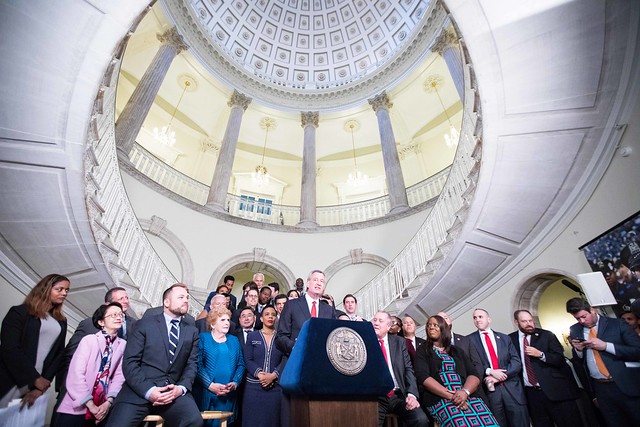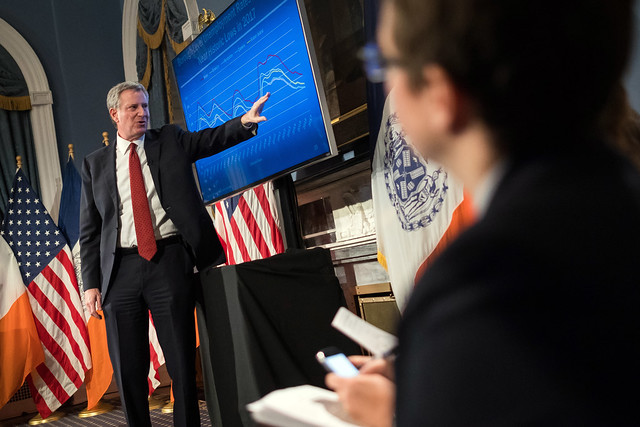The Fading Promise of Property Tax Reform

(photo: Benjamin Kanter/Mayoral Photo Office)
Despite promising that in his second term he would take on the challenge of property tax reform, Mayor de Blasio appears to be shying away as many leaders have done many times before.
New York City government is extremely dependent upon its property tax, which will generate roughly $30 billion this coming fiscal year, more than any other single revenue source. Not surprisingly, New Yorkers gripe about their property taxes almost as much as about the subways.
The laws and methods used to determine and assess the tax on individual properties are extremely complex and inequitable, but reforming them is a daunting task that will inevitably make some property owners unhappy. For that reason, elected officials have long avoided tackling the problem.
The current New York City property tax system was created in 1981. A lawsuit brought by law professor William Hellerstein in 1975 challenged the legality of the property tax system state-wide as violating the constitutional requirement that all similar properties be taxed equally.
After several missed deadlines, rejected proposals, and a last-minute override of Governor Carey’s veto, a new law was passed that divided properties in New York City into four “classes,” set different percentages of the value of each class of property to be assessed (assessment ratios), limited the amount of total property tax levy to be derived from each class (class shares), and provided for phase-ins and limitations on the growth of tax revenue from different classes so that no one property or type of property would experience a dramatic increase in value and taxation as the new system was phased in.
Thirty-eight years later, New York City looks quite different, property values have soared, and there have been many unintended consequences of the design of the property tax system.
Limitations on phasing in growth in value mean that properties within the same class are often taxed at very different effective rates and the limitations on class shares of the tax levy mean that different classes are shouldering disproportionate amounts of the burden of the growth in overall property value.
One of the most egregious outcomes is that co-ops and condos -- for which the market was very different in 1981-- are in the same class as rental properties and are assessed, not on their market value, but as if they were only generating rental income. The result is many high-end apartments assessed at far lower amounts than their real value; whole residential co-op and condo buildings in some parts of Manhattan are taxed at less than the actual sales prices of individual apartments in the building.
What is to be done? In April 2017 a group of frustrated real estate developers and landlords joined with individual property owners and supportive civic and civil rights groups (including Citizens Budget Commission, which I led at the time and filed an amicus brief) to file a new lawsuit, Tax Equity Now NY LLC vs. City of New York, et al. alleging the current property tax system discriminates against primarily people of color who are low-income renters and homeowners. The lawsuit was filed in the hope that, as had happened in response to the Hellerstein case, city and state leaders would respond with urgency and determination to develop a reformed taxation system.
Instead, both city and state defendants have strenuously resisted the suit, moving to dismiss it on the grounds that the plaintiffs aren’t directly impacted and/or that the state defendants aren’t responsible. The City also infuriated City Council members who wanted to intervene on behalf of the plaintiffs by opposing their application to file a separate brief.
The motion to dismiss was filed in June but it took until September 2017 for the judge to rule that the case could proceed and until February 2018 to rule that the Council members could not intervene in the case. The City filed an appeal and all further action in the case is on hold until that appeal is decided.
At a breakfast hosted by the Association for a Better New York the day before he was re-elected in November 2017, I asked Mayor de Blasio whether he was going to take on property tax reform. He answered directly and forthrightly that the system needs to be more fair and transparent but that we cannot afford to reduce substantially the revenue it generates and that relying on the judicial system to resolve the problem would be a mistake.
He estimated that it would “take a year or two” to bring all the stakeholders together and come up with the needed reforms and that it would require being “blunt” about the challenges. He said: “I am ready to do it….When I say something that definitively, I mean it…We will create tax reform.”
It took until May 31, 2018, more than a year after the Tax Equity Now case was filed and now a year ago, for the Mayor and the City Council Speaker Corey Johnson to announce the formation of an Advisory Commission on Property Tax Reform. Co-chaired by former city Housing Commissioner Vicki Been, then faculty director of the NYU Furman Center, and former First Deputy Mayor and then Interim COO of CUNY Marc Shaw, the commission was charged to “develop recommendations to reform New York City’s property tax system to make it simpler, clearer, and fairer, while ensuring that there is no reduction in revenue used to fund essential City services.”
No deadlines were specified, but the commission was instructed to conduct at least 10 public hearings.
All the public hearings and meetings were recorded and are available online. The last one was held this past February 28. Yet there is still no word on what the commission will recommend or when it will publish its report. The state legislative session is almost over so it is too late to achieve any changes this year and Been has become a deputy mayor with a lot more on her plate.
So the mayor’s promises notwithstanding, an opportunity to rationalize our property tax system and make it more fair has been missed and the commission looks more like a stalling device than a sincere effort to make tough decisions. Who wants to make New York property owners unhappy during a presidential campaign? As was the case four decades ago, it appears that we will need a lawsuit to compel elected officials to make tough decisions.
***
Carol Kellermann was president of Citizens Budget Commission from 2008 through 2018.
***
Have an op-ed idea or submission for Gotham Gazette? Email This email address is being protected from spambots. You need JavaScript enabled to view it.
***
Have an op-ed idea or submission for Gotham Gazette? Email This email address is being protected from spambots. You need JavaScript enabled to view it.
The Rainy Day Fund New York Needs

(photo: Ed Reed/Mayoral Photography Office)
With so much attention focused on the mayor’s presidential campaign, rent regulation renewal, and the state of the transit system, most New Yorkers are unaware they will have the opportunity this fall to vote to dramatically change their city government.
The 2019 New York City Charter Revision Commission is considering what amendments to the City Charter, which defines the structure and powers of city government, it will recommend to voters for a yes or no vote on the November ballot. Notable proposals include ranked-choice voting for local elections, enhancing community board review of land use proposals, and multiple changes to the city’s budget process.
One budget proposal the commission should approve and advance to voters in November is the creation of a Rainy Day Fund (RDF). An RDF is essentially a savings account that would allow city government to put away revenues received when the economy is growing and use them to stave off the most crushing service cuts and tax increases during an economic downturn or catastrophic emergency—the rainy days.
To weather the last two recessions, the city reduced police and ambulance staffing, cut library hours, suspended recycling, and increased personal income, sales, and property taxes. A well-structured RDF can ameliorate the need for this level of municipal pain, helping everyone from those who depend on city and social services to individuals and businesses feeling the strain of high taxes.
By and large, charter provisions and state laws enacted in response to the 1970s New York City fiscal crisis provide a strong budgeting and financial management framework that has served New York well—producing balanced budgets and prudent revenue estimates, while allowing the city to fund services New Yorkers desire.
Ironically, the city charter’s balanced budget requirement, among the most stringent in the nation, is what makes using an RDF impossible. Balancing the annual budget requires city services delivered in one year to be funded only with revenues generated that same year. Saving money in a strong economy to use later in a recession misaligns that timing, and violates the accounting rules relied on by the charter.
The solution is for the charter commission to leave the charter’s budgeting and financial management framework intact except to seize the opportunity to improve the charter by allowing an RDF, well structured to preserve both long- and short-term stability.
Absent an RDF, the city has devised legal work-arounds to provide some fiscal cushion. The city pre-pays expenses, freeing up money in the next year. The city has also used its Retiree Health Benefits Trust—money put aside to pay for municipal employees’ retirement health benefits—as a de facto RDF by paying for current bills with the trust’s assets rather than budget revenues.
These workarounds are problematic. Not enough money can be put aside; there are limits to what and how many expenses can be prepaid. In addition, there is no requirement to put money aside even in the best of times. Finally, using the RHBT as de facto RDF makes future taxpayers pay for current bills, which is hardly fair to the next generation.
True, the city has set aside some funds. The current financial plan includes $1.25 billion annually for reserves, but this pales in comparison to the need. Citizens Budget Commission estimates the projected three-year revenue shortfall from a recession comparable to the past two would be $15 billion to $20 billion.
How would a well-designed RDF be structured? The first step is to determine the right size of the fund. Based on past revenue trends, CBC estimates that 17 percent of tax revenues would be a good target size to mitigate a recession or emergency’s most damaging impacts.
Second, regular deposits should be required during economic expansions. CBC recommends annual deposits of 75 percent of all tax revenues in excess of 3 percent growth; this would allow spending on services to grow in excess of long-term inflation and still generate substantial RDF resources. Had this been in place during the current record-long recovery, the city would now have nearly $9 billion in its RDF.
Finally, withdrawals should be limited to periods of recession or emergency. Economic triggers should be defined in law and RDF funds should not all be used in one year.
By putting a Rainy Day Fund on the ballot, the charter commission would provide New Yorkers with an important opportunity to strengthen one of the few flaws in the city’s budgeting processes and would create significant momentum for the changes needed in state law.
Yes, some more political and proximate issues may be more galvanizing, and sadly, elected leaders and the public too often accept as inevitable the pain of hard choices during a recession. However, the annual impact of modest deposits in the good times will be significantly outweighed by preserving the services New Yorkers need during times of economic hardship.
***
Andrew Rein is president of Citizens Budget Commission. On Twitter @cbcny.
***
Have an op-ed idea or submission for Gotham Gazette? Email This email address is being protected from spambots. You need JavaScript enabled to view it.
For Racial Justice, Cuomo and Legislative Leaders Must Pass Marijuana Legalization

(photo: Governor's Office)
We are days away from the end of the legislative session and among the many important issues Governor Cuomo and New York legislators have left to accomplish is addressing the racially-biased and unjust enforcement of marijuana prohibition in our state.
The Marijuana Regulation & Taxation Act (MRTA), currently being considered by New York lawmakers, is one of the clearest pathways toward reducing racism in New York. In the last 20 years our beloved state has earned the dubious distinction of becoming the marijuana arrest capital of the country, with more than 800,000 arrests made just for possession of small amounts.
Nearly 80% of those arrested have been people of color, even though drug use occurs at similar rates across racial and ethnic groups.
These arrests are not a trivial matter. They involve being handcuffed, placed in a police car, taken to a police station, fingerprinted, photographed, possibly being held in jail for up to 24 hours while awaiting arraignment before a judge, appearing in court several times over the course of months, and potentially concluding with the imposition of a permanent criminal record that can easily be found online by employers, landlords, schools, credit agencies, and banks.
New Yorkers who are arrested often face consequences that can make it difficult to get and keep a job, maintain a professional license, obtain educational loans, secure housing, or even keep custody of a child. This is all for something that is now legal in 10 states and the District of Columbia, and that white people do for the most part without consequences nationwide.
If you are among the many who believe legalization isn’t necessary, believing New York’s decriminalization law protects people of color from law enforcement harassment, let me share the reality of what happens in our communities.
While it is currently illegal to sell marijuana, you are not technically supposed to get arrested for possession of small amounts. But New York’s decriminalization law, which we’ve had for 40 years, is failing. More than 60 people on average are still arrested every day for marijuana possession in the state. These arrests have been largely justified by a loophole allowing police officers to distinguish between public and private personal possession. Because possession in “public view” remains a crime—and the fact that there is pervasive and racially-biased over-policing of communities of color—mass arrests continue.
The MRTA will not only put an end to these racist police practices, but will create a responsible and well-regulated industry that will better restrict minors’ access to marijuana. It will also generate millions in tax revenue to bolster the state economy and support the communities that have been most harmed by marijuana prohibition.
The bill additionally works to address some of the unjust consequences of marijuana prohibition by creating a process for both the reclassification of past convictions related to marijuana and for the resentencing of currently incarcerated individuals who are serving time due to a marijuana-related offense. This provision of the legislation will remove significant barriers that New Yorkers face in the wake of a marijuana conviction and allow them to fully participate in society without the devastating toll of collateral consequences.
New Yorkers can feel assured knowing that the sky did not fall in states like Washington, Colorado, Oregon, and Alaska that have legalized the adult use of marijuana. Use by minors has not gone up, and there has been no increase in driving under the influence. We have the major benefit of learning from hurdles these pioneering states had to overcome, and incorporating lessons learned.
The drug war has left a lasting impact on generations of New Yorkers, particularly harmful for people of color. State resources that could benefit our communities are instead being used to perpetuate wasteful and damaging prohibitionist policies that have not been successful in curbing use, increasing public health, or benefitting communities.
The MRTA will not only earn the state billions in revenue, but will reinvest some of this money back into the communities that have been most harmed with adult education services, job training, the expansion of afterschool programs, re-entry services, and other community-centered projects. Money will also be directed toward public schools as well as drug treatment programs and public education campaigns geared toward reducing opioid overdoses and saving lives. It is a win all around.
It is time to stop the ineffective, racially-biased, and unjust enforcement of marijuana prohibition and to create a new, well-regulated, and inclusive marijuana industry that is rooted in racial and economic justice. If Governor Cuomo and New York legislators are really interested in curbing racism in our state, they will pass the Marijuana Regulation & Taxation Act this legislative session.
***
L. Joy Williams is the President of the Brooklyn NAACP. On Twitter @LJoyWilliams.
***
Have an op-ed idea or submission for Gotham Gazette? Email This email address is being protected from spambots. You need JavaScript enabled to view it.




